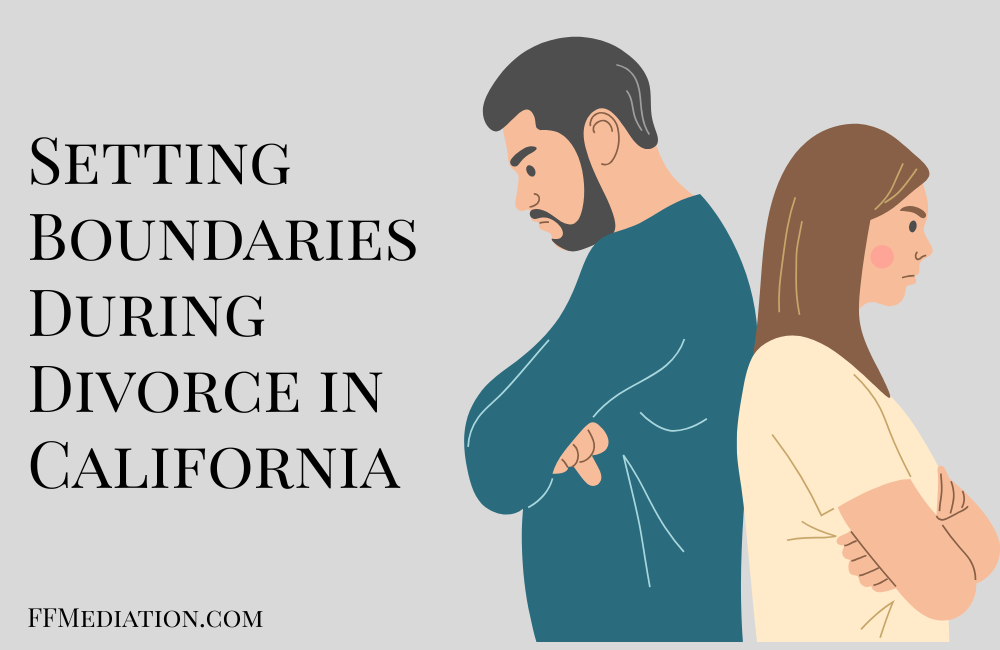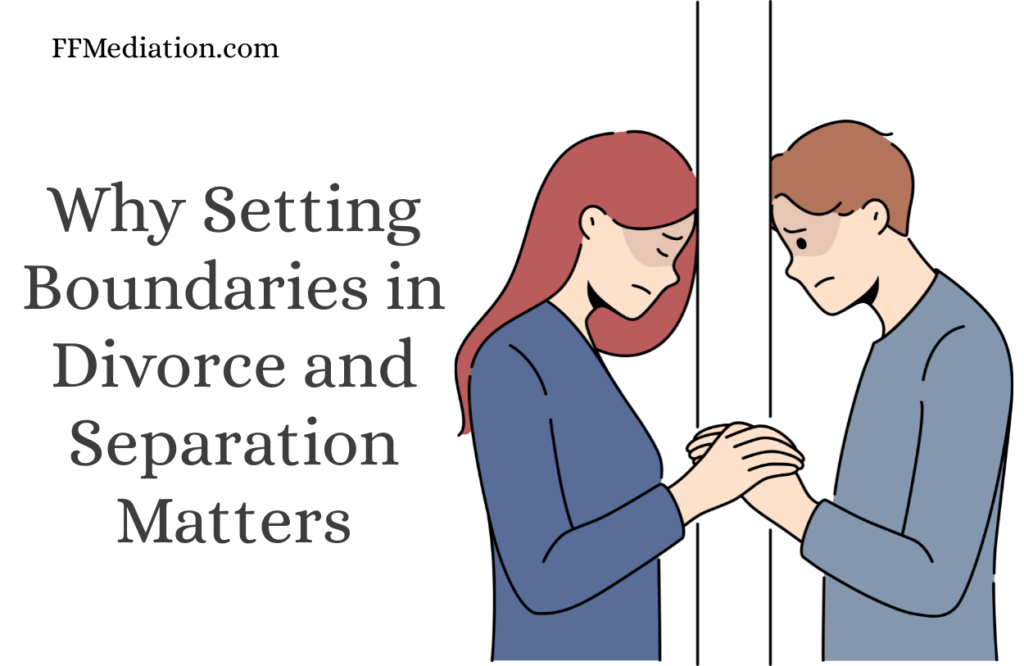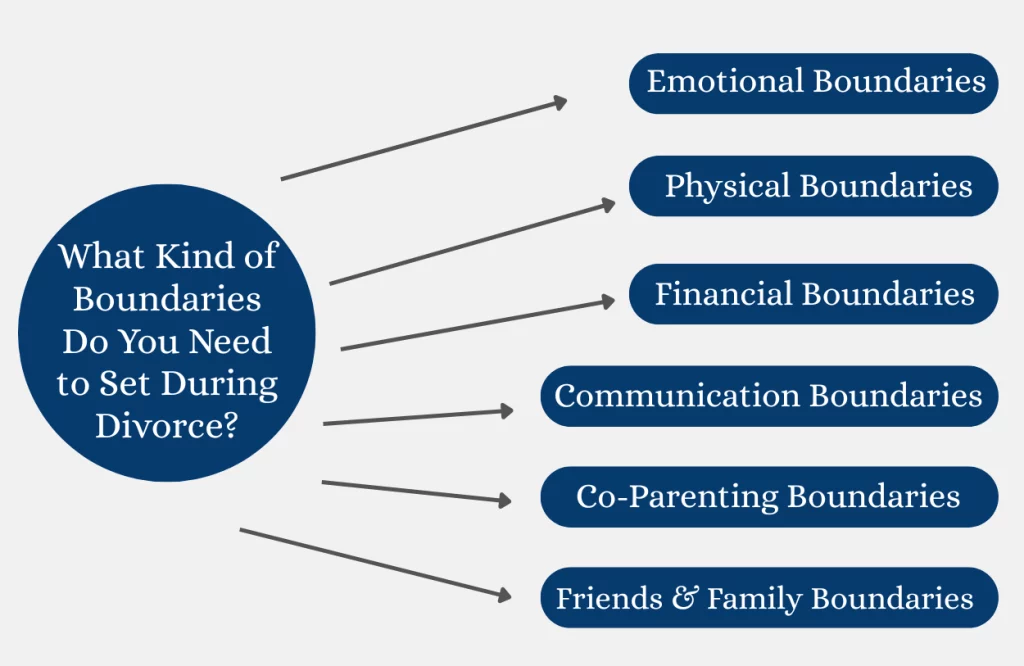Providing Divorce Mediation Services Throughout California
Providing Divorce Mediation Services Throughout California
Home » Divorce and Family law Blog » Setting Boundaries During Divorce in California (2025)

Inside This Article
Divorce is difficult, but boundaries can help protect your mental health, your finances, and the children (especially in California where divorce is no fault).
Lack of boundaries can lead to unnecessary disputes if the parties are living together through the divorce process or if they are co-parenting afterwards.
In this guide, we will help you set emotional, physical, financial, and communication boundaries so that you can reduce your stress, and feel more control over your circumstances.
If tensions are running high, mediation with a mediator such as Families First Mediation provides a structured negotiation process that is less adversarial than court.
Having a clear process can help make the divorce smoother for all parties involved.
Get a FREE Divorce Mediation Consult with Dina Haddad, a California divorce expert, today!
Boundaries are clear, firm limits that define how you and your ex-spouse interact during and after divorce. They protect your emotional well-being, finances, and parenting responsibilities.
Without them, conflicts escalate, stress increases, and the divorce process becomes more difficult than it needs to be.

You need boundaries before filing (to prevent unnecessary arguments), during the legal process (to avoid manipulation or power struggles), and after divorce (for healthy co-parenting or complete separation).
Establishing them early helps both spouses navigate the marriage separation with less resentment and confusion.
Surviving while living together during divorce is difficult. It may require you setting clear boundaries, establishing a co-parenting schedule, and monitoring your health. Check our 10 actionable tips on living together during divorce.
Healthy boundaries keep things respectful, structuring all your interactions during the divorce to prevent conflict. Some restrictions you can add include:
These limitations will help reduce conflict whilst allowing for cooperation as needed.
Weak boundaries invite conflict, control, or emotional injury. Please consider the examples listed below:
Having strong boundaries does not mean you are being harsh or unfeeling; it means you are safeguarding your peace and moving forward.
Divorce can be chaotic, but boundaries can bring order to the chaos. These 6 rules preserve your peace, your money, and the kids. Start with one boundary and build the others as you continue.

Your feelings count. Don’t allow your ex to manipulate you into guilt, anger, or past arguments.
If they are yelling or blaming you for something, just walk away. You control what conversations you have.
How to set it: You need to stand your ground and say: “I will not discuss this if you raise your voice.”
While living together during a divorce, it is crucial to establish your boundaries (bedroom, office, etc.), and equally important to recognize and respect your spouse’s.
You should consider setting quiet times. If tensions are high, you may want to sleep in separate spaces.
How to set it: Fairly dividing up common spaces and clarify which spaces are off limits. Establish all common spaces as common space. If tensions are high, retreat to your space immediately.
Under California community property laws, all property and debts are divided equally, which means people rarely divorce without splitting assets.
If you are concerned and want to ensure there are no surprise withdrawals or hidden spending,immediately separate your finances.
How to set it: First, open a new banking account under your name only. Second, cancel all joint credit cards. Third, save copies of your financial statements.
Stick to conversations that matter, which are your kids, bills, and legal issues. Set clear parameters of when and how you will talk to avoid unnecessary fights during these conversations.
This will help keep your conversations constructive instead of emotional.
How to set it: Parenting apps, schedule specific times to talk when important things arise, block/mute your ex on social media, and keep your messages short and factual.
Establish clear and consistent rules related to visitation and parenting decisions to provide as much stability for the kids as possible.
Make decisions collaboratively when developing visitation schedules, discipline approaches, and decisions about anything from school to medical choices.
As much as possible, discussions of anything child-related should remain calm, neutral, and focused on the children and their needs, not your “issues” with each other.
How to set it: Find a shared calendar to use to schedule visitation or school events. Always communicate through a parenting app or email. Do not ever argue in front of the kids. Split costs fairly and stick to the agreed plan.
Protect your privacy by setting a boundary with those close to you. Ask them to do you a favor and avoid gossiping or sticking their nose in your divorce too much.
You are in charge of what you say and if you don’t want to share you simply say, “I’m not ready to talk about it.”
How to set it: Decide on a few people you can confide in about your divorce and at the first uncomfortable question from anyone else, ask them to change the subject.
Establishing boundaries during the divorce process can take planning and courage. There are some steps to take, so plan ahead, stay as calm as possible, and be clear about your needs.
Pro Tips: Write down your boundaries before discussing them to stay focused.
Identify what is most important when addressing certain matters such as your emotional health, your finances, and your kids.
For example, if custody exchanges turn hostile, this may indicate the need for a neutral place to drop-off or pick-up the kids. Make a list of your top needs before you speak to your ex.
Use simple, direct “I” statements such as “I need to restrict our texting to conversations related to the kids.”
Also avoid being emotionally reactive and avoid blame even if it’s warranted. For example, one couple was able to curb fights by merely limiting important conversations like their kids and finances to emails.
When your ex ignores your boundaries, reinforce them by saying no. When working with narcissists, use the “gray rock” method (be as boring and as unemotional as possible).
It’s a different situation if they threaten or continue to harass you. In such a situation, you may consider or file for a restraining order against them in California.
You do not have to do this alone. A therapist can help you with all the stress, a divorce coach can help you with strategy, and a mediator (like Families First Mediation) can help you reach agreements that are fair.
It takes a while to get the hang of setting boundaries, but it gets easier. Stay firm, protect your peace, and contact professionals when you need help. You deserve an easier divorce.
Co-parenting tends to be most successful after a divorce when boundaries are clearly outlined.
Given California courts also seek stability for children, your boundaries should pursue a similar stability. Here are some co-parenting boundaries to consider:
With co-parenting plans, start with a more stable custody arrangement to establish consistency for the children.
For example, the plan should have a fixed routine when it comes to days of the week with one parent, weekends with the other parent.
In addition to the original custody schedule, create a shared visual calendar with holidays and school calendars to avoid confusion that lead to last-minute changes.
Protecting children from conflict means always keeping adult conversations private. To be specific, never argue in front of them and never use them as messengers.
Contact each other using a parenting app, like OurFamilyWizard, that keeps all communications on record and focused on the children.
Under California law, courts generally prefer joint physical and legal custody, and sole custody is only used when one parent is unfit.
In order to obtain sole custody through a motion, you will need to demonstrate abuse or neglect, and this requires irrefutable evidence.
If the parents have a considerable amount of conflict between themselves, it may be best to create a detailed co-parenting plan.
The co-parenting plan should include details about visitation, holiday scheduling, and how to resolve any future disputes.
A neutral mediator like Families First Mediation offers the best opportunity to create this agreement, as they can help parents focus on the needs of their child or children instead of their differences.
Contact Families First Mediation today to set clear co-parenting boundaries!
If you are coping with a highly manipulative ex, watch for red flags such as gaslighting, guilt tripping, and chronic noncompliance to the rules. React by remaining calm, documenting all instances.
Use the gray rock approach – keep it boring and don’t show any emotion, so that you don’t encourage their drama.
As a California resident, you have the option of applying for restraining orders, custody mediation with a narcissist, or custody changes if the other parent doesn’t respect your boundaries.
When you are going through a breakup, consider by muting or blocking your ex on social media. It could be a necessary step to protect your peace of mind.
Along with protecting your peace, you should also take the necessary steps to protect your privacy. If you have shared accounts with your ex, remove them from those as well.
Also, you should remove them from any location tracker you may be using on your phone or other smart devices.
While you may find comfort in your own personal space, realize that targeted ads could still show painful updates; so adjust your ad preferences to manage that as best you can.
If you live in California, you also have the option of using the CCPA (California Consumer Protection Act) and request your login information or personal data to disappear from websites you may have interacted with; which can provide some protection during this time.
Even with boundaries, obstacles can appear. This is how to address three common difficulties:
If your ex-partner is continually crossing your boundaries, consider whether you need to pursue legal actions, such as , modification of child custody, or a restraining order in California.
When feeling overwhelmed by guilt, practice mindfulness – take a pause, take a breath, and remind yourself that boundaries are good for both people.
Counseling like Dr. Invia San Jose Counseling can arm you with tools to help you fight emotional manipulation.
If you find yourself having a dispute with your co-parent, refer to the outlines of California’s guidelines for co-parenting.
For high-conflict matters, mediation through a professional like Dina Haddad can speak to both parties and provide neutral solutions to the problem that puts the child first.
Boundaries in your California divorce can protect your peace, your finances and your children. When you maintain a firm and consistent presence, you will diminish conflict and create space to heal.
Remember, you don’t have to do this alone. To help you through your divorce, reach out for a FREE Divorce Mediation Consultation with divorce expert Dina Haddad. Wherever you go from here, your foundation for stability lies in the steps you are taking today.